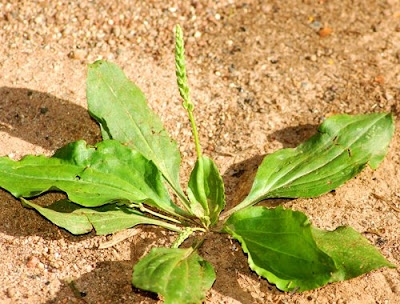
I was out gardening this morning when suddenly that sharp, paralyzing feeling shot up my hand—I’d been stung! Seems our little farm is wasp-haven, and I am not winning the battle with hosing their nests down from the eaves of my house, and from their various hiding places.
I looked around the grass and found plantain. I don’t like to use poisons (hence the wasps, plus the weeds in the grass), so fortunately, plantain was right there, growing in my lawn. I chewed up a leaf and quickly put the pulp on my sting. It’s magic—it really is! It always amazes me how fast plantain makes you forget you were stung.
When I came inside to shower, as soon as I washed off the plantain, the sting started hurting again. That plantain is really like magic! It’s nickname is “Band-aid Plant” and it is regarded as one of the best healing herbs. The active ingredient is a powerful anti-toxin. Native Americans called it Snakeweed and carried it in their medicine pouches to treat snakes bites. Plantain stops pain quickly, speeds healing, stops bleeding, draws out foreign matter, stops itching, prevents and stops allergic reactions from bee stings, kills bacteria, and reduces swelling. Use it on sprains, cuts, insect bites, rashes, boils, bruises, chapped lips or hands, baby’s bottom, and burns.
Something inspiring I learned about plantain is that it grows within a close distance to poisonous plants, like stinging nettle. God gave us the cure right next to the trouble, like he does so often in our lives. I’ve hunted it down on hikes or at the park, when a child is stung. It grows in most lawns, to the distress of the gardener. It grows most everywhere, including parks, playgrounds and in the cracks of the sidewalk. There is a broad-leaf version (like the photo) and the narrow leaf version. The most distinguishing feature for me is that if you turn over the leaf, there are 5 prominent veins are parallel to each other and run the length of the leaf. It also sends up a stalk with a “cat tail” looking seed-thing on the top. The seeds of plantain are sold as Psyllium, a bulking fiber (to treat constipation).
If you want to have plantain around in the winter, here’s some ways to store that magic:
Easiest:
You can dry the leaves and put them in your first aid kit. Chew them just as you would a fresh leaf, and put it on the wound. Works well.
A little harder:
You can also make a Plantain Oil. Just stuff a small glass jar with coarsely-chopped fresh, plantain leaves. They must be dry, so it is best not wash them. (Think that they were rained on or watered recently and they are clean. Pick those away from footpaths or roadsides and you’ll get cleaner plants.) Fill the jar tightly with leaves, and pour in olive oil to completely cover. Use a wooden spoon handle to prod the leaves, pushing them down and releasing air bubbles. Make sure all leave are submerged in the oil. Add a little more oil to the top and cap tightly. Put this jar in your pantry on a plate to catch any drips, and leave it be for 6 weeks. If you happen to notice it, you might shake it a bit every few days. If not, it will still be good. At the end of 6 weeks, pour the oil through a strainer, pressing the leaves with the back of a spoon to release all the oil. Label and store in a dark place, preferably in a dark glass bottle. Now, when you need plantain, use the oil just like you would a salve. Rub it on, or drop some on the bandage to put up against a wound or sting.
A little more trouble still:
You can gently heat beeswax to mix it with the oil, at the ratio of one tablespoon grated beeswax to about one ounce of oil. Pour this into a little tub and it will cool into Plantain Ointment.
Fresh is easiest, and works the best—just like magic! Don’t let your kids suffer from stings this summer without showing them how to fix it with plantain.


Comments on this entry are closed.